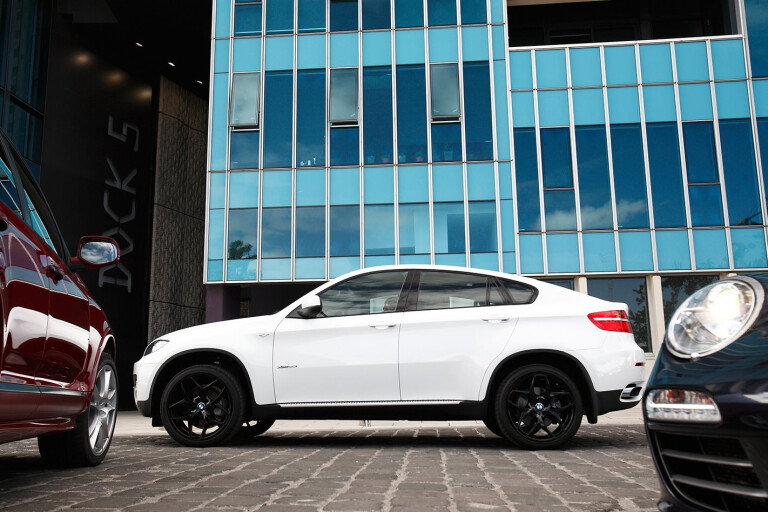
If you opened a wildlife magazine to a story where the opening photo included a barracuda, a bull elephant and a cocker spaniel on stilts, you’d be hoping there’d be a caption that explained all.
This review was first published in MOTOR Magazine March 2009.
And I’m tipping you’re looking at this page and thinking pretty much the same thing. How the hell does a Porsche 911 and Cayenne end up on the same page of a MOTOR comparison? And can somebody please talk me through the inclusion of the BMW X6 in the same mix?
In fact, to hell with context, can anybody explain the X6 to me at all? See, if you listen to the folks at BMW, you’ll be told that the X6 (and I’m not making any of this up) is a four-wheel-drive, a coupe and (perhaps most intriguingly) “handles like a 911”.
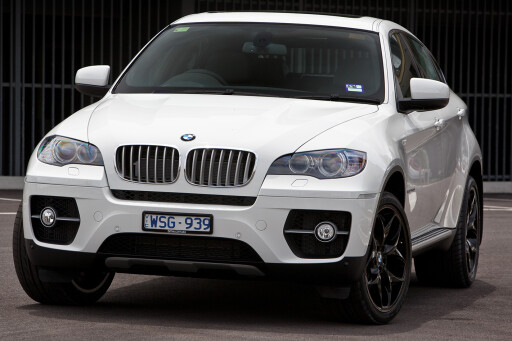 As well as taking the risky step of comparing one’s product directly with that of a competitor, it’s also a hell of a big statement, because very few things with number plates handle anything like Porsche’s butt-motored icon. And you just know that statements of that sort are a bit of a red rag over here at MOTOR, so we figured we’d put the talk to the test.
As well as taking the risky step of comparing one’s product directly with that of a competitor, it’s also a hell of a big statement, because very few things with number plates handle anything like Porsche’s butt-motored icon. And you just know that statements of that sort are a bit of a red rag over here at MOTOR, so we figured we’d put the talk to the test.
Of course, we figured we’d give the X6 the best possible chance of living up to the claim, so that meant choosing the all-paw 911, the Carrera 4, in this case the S model with the all-new 3.8-litre, direct-injection flat six.
It’s no secret that the all-wheel-drive version of the 911 is not as pin-sharp on a racetrack as the rear-drive model, but it does have more grip for the other 95 percent of tasks owners will put it to and it's a better technical match for the X6. And on that basis, we also opted for the new PDK dual-clutch seven-speed transmission.
So, to the X6 – the vehicle that has taken niche SUVs to new levels of nicheness. Looking for a car with M3 grunt and jacked-up, quasi-off-road suspension? Or what about an X5 with none of the luggage space? Then the X6 could be your buggy.
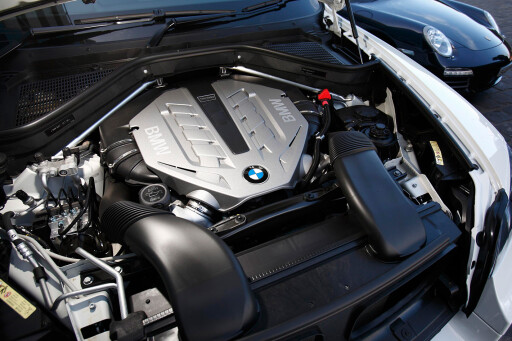 The version we grabbed has BMW’s twin-turbo V8, so it cranks along with a proper soundtrack and 300 meaty kilowatts from its 4.4 litres. Torque is a mind-boggling 600Nm at just 1750rpm, underlining the willingness of modern turbos to sink the boost early.
The version we grabbed has BMW’s twin-turbo V8, so it cranks along with a proper soundtrack and 300 meaty kilowatts from its 4.4 litres. Torque is a mind-boggling 600Nm at just 1750rpm, underlining the willingness of modern turbos to sink the boost early.
As well as the full suite of computer-controlled stability and traction functions, the V8 X6 also has Adaptive Drive (lesser models can be optioned with it) which amounts to active stabiliser bars and dampers that can be firmed up by pressing the Sport button on the centre console.
Now, comparing the X6 with a traditional Porsche is one thing, but let us not forget that Porsche also has a pretty convincing SUV of its own in the form of the Cayenne. So why not throw it in, too? We could have opted for the mega-expensive Cayenne Turbo, but instead we chose the GTS version which is a) cheaper and, b) a nicer car to use.
In the GTS, you’re more or less getting the Turbo specifications but without the turbo engine, so you keep the big brakes, tyres, firmer (and like the BMW, air-adjustable) suspension, seats and styling. But the Cayenne, even in its sub-Turbo GTS trim, is still a much more serious off-road package than the BMW thanks to a proper set of low ratios and a centre diff-lock.
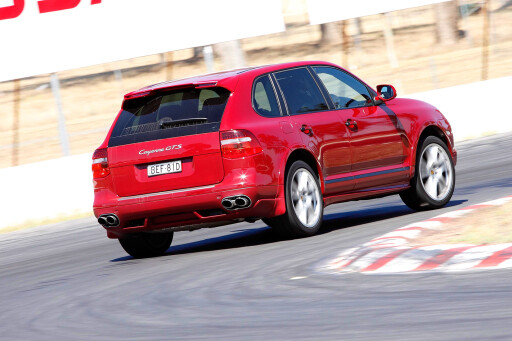 The X6, meanwhile, makes do with a variable torque split that normally operates at 40/60 front-rear but can send all the torque to one axle or the other should the conditions dictate it. It will not, however you wish to look at it, do the job in really rough, snotty terrain, whereas the Cayenne will.
The X6, meanwhile, makes do with a variable torque split that normally operates at 40/60 front-rear but can send all the torque to one axle or the other should the conditions dictate it. It will not, however you wish to look at it, do the job in really rough, snotty terrain, whereas the Cayenne will.
If that’s your agenda. Ahem. All of which modifies our quest a little. Because as well as finding out whether the BMW X6 really is as handy a handler as a Porsche 911, we’re also aiming to find out – just in case, you understand – whether the BMW X6 is as handy as a Porsche Cayenne at being an SUV.
Actually, the second part is pretty easy to answer. Um, the X6 is actually not anywhere near as useful as the Cayenne. But then, just looking at the pictures here, you’ve probably worked that out for yourself. The big problem is in the way the BMW’s roofline falls as it sweeps back towards the big, one-piece tailgate.
 The rear side glass becomes very shallow and the luggage space is ditto super-shallow. Think Jack Russell, not Labrador. And leave the mountain bike at home. In fact, leave the third child at home, too, because the BMW’s rear seat is a two-holer. And while forward vision isn’t too bad (despite pretty hefty A-pillars), the view out the back is a raw deal.
The rear side glass becomes very shallow and the luggage space is ditto super-shallow. Think Jack Russell, not Labrador. And leave the mountain bike at home. In fact, leave the third child at home, too, because the BMW’s rear seat is a two-holer. And while forward vision isn’t too bad (despite pretty hefty A-pillars), the view out the back is a raw deal.
The rear windscreen is so shallow and angled so steeply, you end up with a slit to look out of. And since there’s no window wiper, it soon becomes a grimy or rain-spotted slit that leaves you with just the exterior mirrors to spot the cops sneaking up on you.
The luggage floor is also quite high, to the point where it’s an issue for short people bearing heavy shopping bags, but then that’s a criticism you could level at the Cayenne, too. It’s just that because the GTS actually has plenty of luggage and rear-seat space when you do heft the stuff inside, it’s easier to forgive.
That and the fact that the jacked-up ride height actually means something given the Cayenne’s off-road smarts (and it can be lowered pneumatically when parked). Of course, limited luggage and interior space is something the X6 shares with the Porsche 911 and, if the rear seat of the BMW is a bit of a smirk-maker, the back pew in the Porker is a true thigh-slapper.
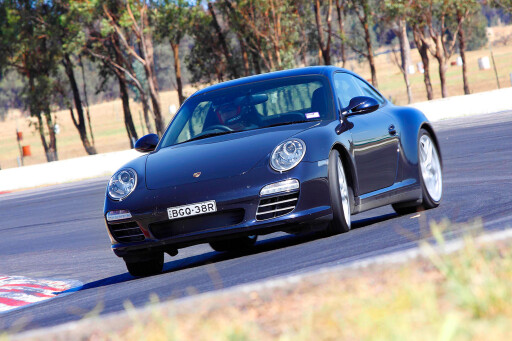 The 911 gets a single luggage space under the bonnet and while it’s quite deep, it’s not a huge opening so anything more than a loosely packed sports bag is off the agenda. But then, the 911 isn’t about carting crap around, is it? No, and it’s here that the real contest kicks off. On the road, the BMW seems to make a pretty decent fist of being a sports car.
The 911 gets a single luggage space under the bonnet and while it’s quite deep, it’s not a huge opening so anything more than a loosely packed sports bag is off the agenda. But then, the 911 isn’t about carting crap around, is it? No, and it’s here that the real contest kicks off. On the road, the BMW seems to make a pretty decent fist of being a sports car.
The active suspension means flat cornering and there’s no shortage of grip. But the steering feels a bit wooden and while it doesn’t extend to actually making the car hard to place on the blacktop, it does mean it’s less satisfying to punt around. But the engine is mega-strong (unless you were told it’s turbocharged, you probably wouldn’t pick it), and the gearbox beautifully fluid and sure of itself.
Against the X6, the Cayenne feels a lot bigger, heavier and simply more like an SUV. But it’s still disproportionately rapid for something that weighs the wrong side of two tonnes (so does the BMW) and it steers with a little more clarity, even if there’s a little body-roll in the final outcome.
The Cayenne also rides better and I remain unconvinced by the X6’s manners over sharp bumps and the tyre roar from those 21-inchers. And in any case, neither of them can satisfy a driver like the Porsche 911, even at mundane road speeds. Add some enthusiasm and the Carrera 4S is, simply, a thoroughbred.
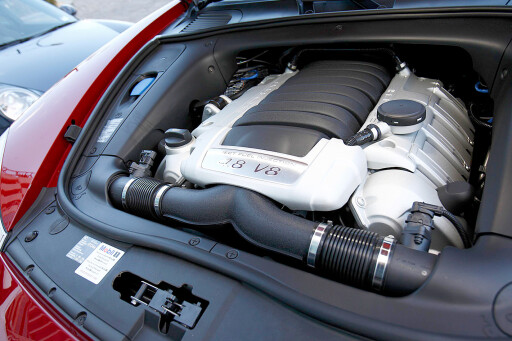 It covers ground like lightning and it’s about as unfussed as a performance car can be. And while driving the front wheels has added grip and stolen a little steering feel, you still drive the 911 with a mixture of fingertips and optimism.
It covers ground like lightning and it’s about as unfussed as a performance car can be. And while driving the front wheels has added grip and stolen a little steering feel, you still drive the 911 with a mixture of fingertips and optimism.
On the dragstrip, the BMW tries hard but even with performance that would shade a supercar of just a decade or so ago, it can’t match the 911. The BMW reeled off a 0-100km/h time of 5.5sec (which, admittedly, is flying) and a standing 400m of 13.7 at 165.6km/h.
And good though that is, it’s clear that its two-plus-tonnes (and no doubt, greater aerodynamic drag) play against it, because the Carrera rattled off a lazy 4.5 to 100km/h and stormed the quarter-mile in 12.6 at 181.7km/h.
The Cayenne was still further back and although 6.8sec to 100 and 14.6 at 156.9 isn’t hanging around, it isn’t in the same league as the other two – despite its power-to-weight parity with the X6. Around the tight Winton circuit, the differences were pretty much maintained.

And the Cayenne? Not that far behind, really, with a best of 1:47.06. If your pockets are deep, but not too deep, then the BMW will claw back some ground. Starting at $145,000, the options including the sunroof (nearly $3.5K) and a stonking $9208 for the black, spoky wheels add up to $161,563 before it hits the road.
The Cayenne GTS wound up at $179,160 as tested, but that includes a cheeky six grand for the ‘special’ colour (it looked red to me) and nearly eight grand for the PDDC (dynamic chassis control). The 911? Erm, a rather scary $303,410 by the time you add $4000 for the adaptive sports seats and seven gorillas for the PDK gearbox.
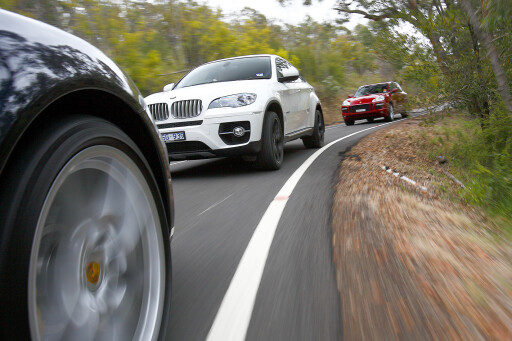 So where does that leave us? Well, while there’s no denying that the X6 is indeed a four-wheel-drive and throws the fact it’s a coupe into the bargain (a coupe can have four doors, look it up), there’s no way it “handles like a 911”. It’s fast and corners hard, but it’s simply beaten up by its own weigh-bridge ticket and towering centre of gravity.
So where does that leave us? Well, while there’s no denying that the X6 is indeed a four-wheel-drive and throws the fact it’s a coupe into the bargain (a coupe can have four doors, look it up), there’s no way it “handles like a 911”. It’s fast and corners hard, but it’s simply beaten up by its own weigh-bridge ticket and towering centre of gravity.
Ultimately, it falls somewhere between the 911 and Cayenne in pretty much every endeavour since it trails one on the road (or track) and the other off it. Even then you could cut it some slack for being big, tough and fast, if only you could fit people and gear in it. But as it stands, it’s hard to conclude that it's anything other than fairly pointless.
Which is not to damn it, but if you’re looking for a real four-seat, four-wheel drive sports car nothing can beat – or handles like – a 911.
| Porsche Cayenne GTS specs | BMW X6 xDrive 50i specs | Porsche 911 Carrera 4S specs | |
| Engine | 90-degree V8, DOHC, 32v | 90-degree V8, DOHC, 32v, twin-turbo | flat 6, DOHC, 24v |
| Power | 298kW @ 6500rpm | 300 kW @ 5500-6400rpm | 283kW @ 6500rpm |
| Torque | 500Nm @ 3500rpm | 600Nm @ 1750-4500rpm | 420Nm @ 4400rpm |
| Kerb Weight | 2225kg | 2190kg | 1480kg |
| Price (new) | $161,900 | $145,000 | $272,000 |

COMMENTS